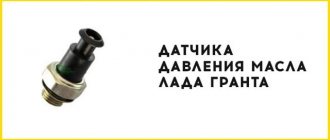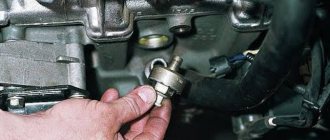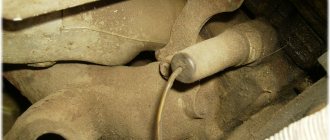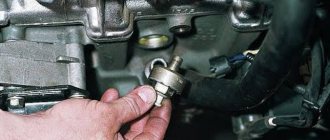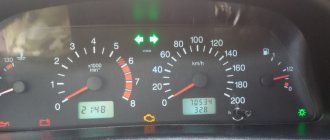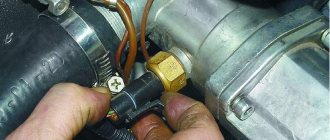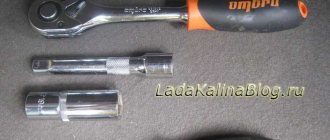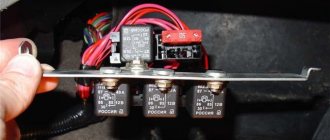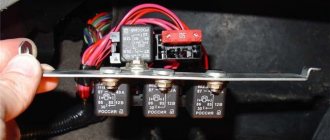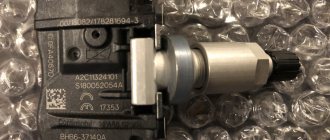I think that many Kalina owners already know that under the hood of the car there are two coolant temperature sensors. One of them is installed on the side of the cylinder head, which sends a signal to the arrow in the instrument panel. And the second is located on the thermostat, and it transmits its readings directly to the ECU to turn on the fan. In this article I will talk about the second engine temperature sensor (coolant).
So, to replace it on Kalina, you will need the following tool:
- Phillips screwdriver
- Driver or ratchet
- Head 19 - best deep
- Extension
Progress of repairs to remove and install the sensor
To make dismantling more convenient, you need to unscrew the clamp of the intake pipe, which goes from the air filter to the throttle assembly:
And after that you need to pull the pipe, pulling it out of its seat. And then move it a little to the side so that it does not interfere, approximately as shown in the photo below:
And the photo below clearly shows the location of the temperature indicator sensor:
First you need to disconnect the power plug, which is fixed in the same way as most others - just lift the latch up and pull the plug:
Now, using an extension cord and a deep socket, unscrew the sensor. If the pipe still gets in the way, you can move it a little more to the side with one hand, and at the same time put on the head with the other. Then unscrew the sensor with a ratchet:
After this, you can completely unscrew the sensor by hand. And this is what it looks like after extraction:
Now you can start replacing this part. Its price is approximately 150 rubles. So, even if you have to change this part, this repair will cost very little.
The cooling system is responsible for the optimal temperature regime of the power plant, at which the power output is maximum. This system includes a radiator cooling jacket and pipes through which fluid circulates. Circulation is provided by a pump driven by the crankshaft.
The system also includes a thermostat, which ensures quick warm-up of the engine by shutting off the pipeline going to the radiator, while the liquid circulates only inside the cooling jacket. When a certain temperature is reached, the thermostat opens the pipe, after which the liquid circulates in a large circle, including the radiator.
The radiator cools the heated liquid. To cool the liquid faster, a fan is installed on the radiator, which creates additional air flow. But this fan does not always work; it turns on only when the liquid temperature exceeds a certain value.
DIY fault repair
We will not talk about solving problems such as failure of fuses or the sensor itself. Everything is so simple here - failed elements are removed from their installation locations and replaced with new ones.
Separately, it is necessary to highlight the replacement of the ventilation unit - read about this below:
- So that during the repair process you do not have to dismantle the radiator, do everything carefully, since there is a possibility of damage to other elements.
- Open the hood and disconnect the battery. Remove the air filter.
- Having done this, you can dismantle the radiator grille.
- Next, you will need to unscrew the top mountings of the optics - the right and left lights.
- Using a 10mm wrench (it will be more convenient to take a socket wrench), you will need to remove the upper front panel.
- After these steps are completed, you will need to disconnect the plugs that are connected to the ventilation unit. Having done this, the wires can be twisted a little.
- Next, using a wrench, you will need to unscrew the four screws that secure the device to be replaced. The arrows in the photo indicate the screws that secure the assembly; they will need to be unscrewed.
- Only after the unit is freed will it be necessary to dismantle it and replace it with a new one. After removal, just in case, clean the connectors themselves so that in the future you will not be bothered by the problem of poor contact. Further assembly of the system and installation of all elements is carried out in the reverse order.
Coolant temperature sensor
To monitor the coolant temperature, a coolant temperature sensor is included in this system. The readings of this sensor are displayed on the dashboard, which provides the driver with information about the temperature conditions of the engine.
But this is not the main task of this sensor. The coolant temperature sensor transmits temperature data to the electronic control unit, after which this unit adjusts the fuel supply depending on the temperature. When the engine is cold, based on the readings of this sensor, the control unit sets an enriched mixture; after warming up, the fuel mixture becomes normal. Based on the readings of this element, the electronic unit regulates the ignition timing.
Causes of failure of the coolant temperature sensor
Structurally, the coolant sensor is quite simple, and accordingly, it rarely fails. Usually this happens simply due to its old age or mechanical damage. For example, corrosion of contacts and metal parts of the case may occur due to the fact that instead of antifreeze or antifreeze, ordinary water was poured into the cooling system (and even more so if this water is “hard”, that is, with a high content of metal salts). Also, the reasons for the failure of this device may be:
- Hull damage . This can be expressed in various aspects. Often, leaks of coolant are visible, which flows from the threads of the sensor or its housing. Also, the electrical contacts and/or the thermistor itself may be damaged, which will produce an incorrect signal.
- Oxidation of contacts . Sometimes situations arise when, under the influence of fumes or simply from old age, the contacts on the sensor oxidize, so the electrical signal does not pass through them.
- Damage to the chip . In some cases, due to mechanical damage, the so-called “chip” may fail, that is, a group of contacts that is connected to the coolant temperature sensor. Simply put, the wires at the base of the connector fray. According to statistics from reviews found on the Internet, this is one of the most common malfunctions that occurs with the sensor and the corresponding system.
- Lost electrical contact inside the sensor . In this case, unfortunately, repair is hardly possible, since usually its body is sealed and does not allow access to the insides of the DTOZH. Accordingly, in this case the sensor only needs to be replaced with a new one.
- Violation of wire insulation . In particular, we are talking about the power and signal wires that go to the sensor from the electronic control unit and back. The insulation can be damaged due to mechanical stress, abrasion, or even simply from old age, when it “peeles” in pieces. This is especially true for those machines that are operated in conditions of high humidity and sudden changes in ambient temperature.
If it is possible to simply clean the body/threads/contacts of the sensor, then to restore its normal operation it is enough to carry out the appropriate measures. However, if the housing is damaged and/or the internal thermistor is damaged, then repair is hardly possible. In this case, you just need to replace the sensor with a new one. Its price is low, and the replacement process is simple and will not take much time and effort even for novice car owners.
Design, principle of operation
The design of this sensor includes a thermistor - a resistor that changes resistance depending on the temperature surrounding it. This thermistor is placed in a metal case with a thread applied to it. A tail section made of plastic is connected to this body. This part contains contacts for connecting wiring. One contact is positive and it comes from the electronic unit, the second is negative and it is connected to ground.
In order for the thermistor to work, a voltage of 5 V is constantly applied to it. This voltage is supplied to it by the electronic unit through a resistor having a constant resistance. Since the coolant temperature sensor thermistor has a negative temperature coefficient, as the temperature increases, its resistance will decrease, and the voltage supplied to it will also decrease. Based on the drop in this voltage, the electronic unit calculates the engine temperature and also displays its value on the dashboard.
The exact installation location of this temperature sensor differs from car to car, but only slightly. It can be installed in the cylinder head near the thermostat housing, or on the thermostat housing itself. It must be located near the outlet pipe through which the liquid flows into the radiator. It is located near this pipe in order to transmit accurate temperature data.
Signs of sensor malfunction
This sensor is considered to be very reliable due to its comparative simplicity of design. However, there may be problems with it too. Usually they come down to a violation of the calibration, which leads to a violation of the resistance and, as a result, incorrect operation of the electronic unit, since it performs part of its functions based on the engine temperature.
One of the most obvious signs of failure of this sensor is the failure of the fan to turn on when the temperature exceeds the set value. But this indicator will not be reliable if there are two sensors - the main one, for transmitting the temperature value to the electronic unit, and the additional one, responsible for turning on the fan. In this case, failure to turn on the fan will indicate damage, oxidation of the wiring, or failure of the sensor responsible for its operation.
On modern cars, a malfunction indicating incorrect operation of the coolant temperature sensor is displayed on the display of the on-board computer. However, a fault message does not always indicate sensor failure. Often problems in its operation are associated with broken wiring or oxidation of contacts.
Incorrect functioning of the coolant temperature sensor or a break in its wiring leads to excessive fuel consumption, high idle speed, and detonation. It is possible that the power unit will have difficulty starting after warming up. The biggest trouble that can occur due to the inoperability of this sensor is overheating of the power plant, which can cause the cylinder head to move.
Sensor location on the engine
In order to check the coolant temperature sensor, you need to know where it is located. Naturally, this information will vary for cars of different brands and models. However, there are several typical signs by which you can find the place where the sensor is directly attached. So, in most cases it is located on the exhaust pipe of the cylinder head. Structurally, it has a metal thread, with which it is screwed into the corresponding hole. The main requirement in this case is to ensure direct contact between its sensitive element and the coolant. It is this contact that ensures the accuracy of the sensor readings.
Please note that some vehicles may be designed to have two temperature sensors installed. In this case, the first of them records the temperature of the coolant at the outlet of the engine (cylinders), and the second - at the outlet of the radiator. This approach makes it possible to more accurately monitor the condition of both the engine as a whole and its cooling system in particular. However, two sensors are usually installed on powerful and/or expensive cars, where this parameter is critically important, and the ECU contains special programs for engine operation. You can find additional information about the design of a particular car in the corresponding manual or technical documentation.
Sensor check
Checking the functionality of this sensor is not difficult. But before you do it, it is advisable to check the integrity of the wiring going to it. You can also check the voltage coming from the control unit. To do this, you need to disconnect the chip with wires from the sensor and connect it to a voltmeter. After this, start the engine and measure the voltage supplied to the sensor; it should correspond to 5 V. If the voltage is normal, check the sensor for resistance.
Replacing the coolant temperature sensor
The coolant temperature sensor cannot be repaired, so if it is found to be operating incorrectly, it is simply replaced.
Video: Replacing the coolant temperature sensor (DTOZH) VAZ 2115 (2113, 2114)
After purchasing a new sensor, it is advisable to immediately check it using the specified methods. If all readings are normal, it is installed in place of the one removed. Before screwing it into the seat, the threads are treated with sealant.
After installing the new element, a leash is connected to it; it is impossible to confuse the position of the chip, since it has special guide grooves. Next, the coolant in the system is brought to normal. Then you should check whether liquid is leaking through the sensor, and then start the engine.
If replacing the sensor does not give any result, the engine continues, for example, to overheat or does not reach the proper temperature, look for the cause in other elements of the system. It is possible that the thermostat does not work and the liquid is constantly circulating either in a small or large circle.
Share with your friends:
The Lada Kalina family car is equipped with over ten digital sensors that monitor the operation of mechanisms and assemblies. Most often, drivers complain about premature wear of the coolant temperature sensor (hereinafter referred to as DTOZH).
They say it displays incorrect data, and sometimes is completely inactive. The process of replacing the DTOZ yourself is not at all complicated. The task can be done by a driver without experience in servicing equipment.
ATTENTION! A completely simple way to reduce fuel consumption has been found! Don't believe me? An auto mechanic with 15 years of experience also didn’t believe it until he tried it. And now he saves 35,000 rubles a year on gasoline! Read more"
Replacement Guide
How is the sensor replaced and in what cases is it necessary to replace the DTOZH? First, let's talk about the malfunctions (the author of the video is Vladimir Tupotilov).
In what cases should the regulator be changed?
If you doubt the functionality of the regulator, you must first carry out a visual diagnosis. The device must show no signs of damage, cracks, or corrosion; the wiring must be intact.
The main symptoms of regulator failure:
- malfunctions of the power unit, especially at idle speed;
- reduced engine power;
- difficult starting and random stopping of the engine;
- increased fuel consumption;
- On the dashboard, the sensor arrow indicates overheating of the internal combustion engine, although in fact it is not.
It is advisable to make the replacement when the engine has cooled down to avoid burns!
Stages
You don't need any specific tools for replacement. Prepare only a screwdriver, a ratchet, and a socket with an extension.
To ensure that replacing the DTOZh does not cause difficulties, you should first unscrew the clamp of the intake line, which goes from the air filter element to the throttle:
- Pull the line and move it a little to the side so that it is out of the way, so you can get easier access to the regulator. Disconnect the battery, since you will have to turn off the power to the controller, and all work related to interfering with the operation of the on-board network must be carried out with the battery disconnected.
- So, DTOZH is in front of you. Now you need to disconnect the power connector, at this stage there should be no problems, since the plug itself is attached in the same way as other sensors. To disconnect, you just need to lift the mount up and pull the connector.
- Next, using an extension cord with a deep head, you need to unscrew the controller. If at this stage the pipe is in the way, try moving it further to the side with one hand, and at this moment install the head with the other. Next, use a ratchet to unscrew the regulator itself.
- Once the threads are loosened, the device can be unscrewed by hand and removed completely. Having done this, you can replace the regulator with a new one; all further assembly steps are performed in the reverse order. As you can see, in general the replacement procedure is not particularly complicated, so it is quite possible to change the regulator at home. You will need no more than 20 minutes to replace, especially since this way you can save money.
What temperature sensors are installed
The principle of operation of the DTOZH is as follows: after receiving data on the current antifreeze temperature, the measuring device sends the readings to the electronic control unit of the ECU.
The on-board computer compares the received data with the programmed ones. In case of discrepancy, an error is indicated on the dashboard. The owner of the car, seeing a system error, decides on the nature of the breakdown and visits a service station to order a comprehensive diagnosis.
In addition to the DTOZH, the Lada Kalina car is equipped with an external temperature sensor (hereinafter referred to as the DNT). However, not on all trim levels, but only on Lux and Premium.
If desired, the owner can install the measuring equipment himself. The installation work is not at all difficult. In time no more than an hour.
DTOZH is designed to monitor the temperature of antifreeze in the cooling system circuit of the power unit. After receiving the “degree” data, the ECU increases or decreases the speed of the power unit in order to adjust the temperature.
The quality composition of the fuel mixture depends on the accuracy of the DTOZ readings. The service life of the sensor is unlimited, with the exception of mechanical damage or short circuit in the circuit.
Where it is located: the standard installation location is the outer part of the thermostat housing. The base is screwed into the thermostat body. Two power contacts are connected to the upper part for power supply from the on-board network.
A melting element is installed inside the DTOZh base. As soon as the antifreeze degree reaches “90”, the contacts close and the on-board computer signals an error.
Next, the driver decides on the advisability of stopping the car immediately, carrying out preventive maintenance, or calling a tow truck.
Catalog articles, prices of temperature sensors for Lada Kalina:
| Name | Catalog item | Price in rubles |
| DTOZH (original), 8 valves | 2112-385101000 | from 250 |
| DNT air (original), 16 valves | 21120385101082 | from 350 |
The device is installed in the mounting location of the front bumper, to the left of the center of the radiator grille. The DNT shape is conical with two contacts on the back side.
The fuse in the mounting block at number 24 is responsible for the operation of the DNT. The absence of temperature readings on the dashboard is the first sign of a malfunction.
